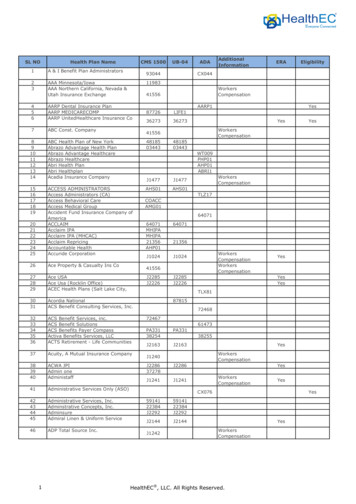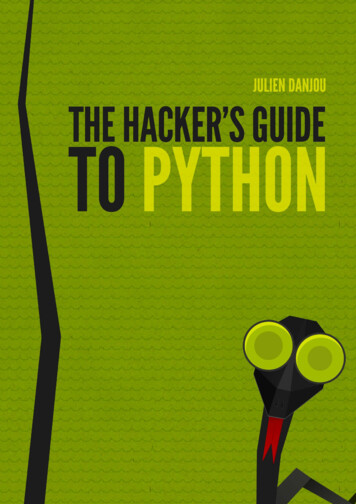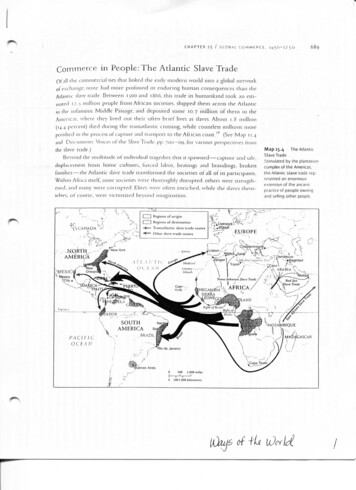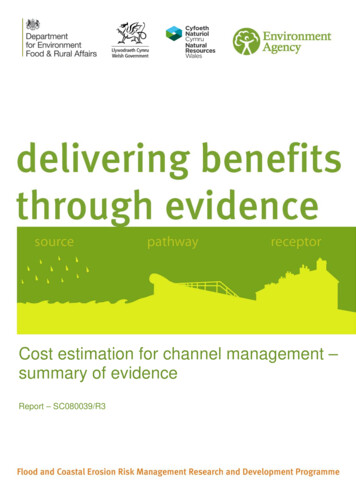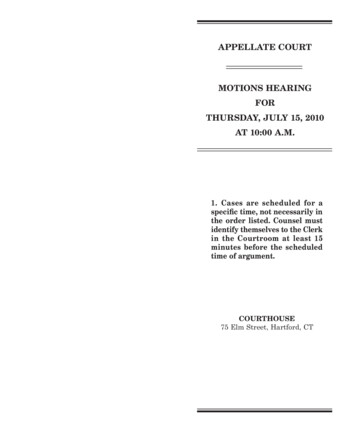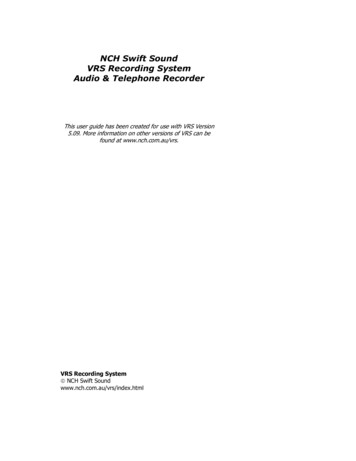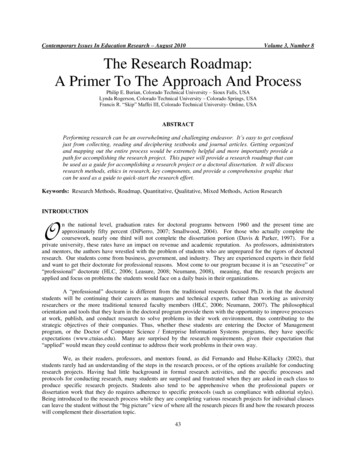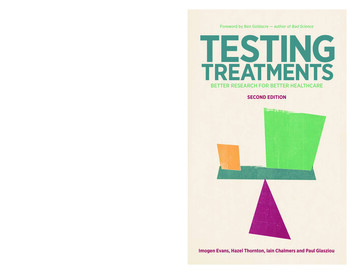
Transcription
Second EditionHow do we know whether a particular treatmentreally works? How reliable is the evidence? And howdo we ensure that research into medical treatmentsbest meets the needs of patients? These are justa few of the questions addressed in a lively andinformative way in Testing Treatments. Brimming withvivid examples, Testing Treatments will inspire bothpatients and professionals.Testing Treatments urges everyone to get involved inimproving current research and future treatment, andoutlines practical steps that patients and doctors cantake together.ISBN 978-1-905177-48-6HEALTH/MEDICINE51795 www.pinterandmartin.comCover design byKlorFor moregreat books visitpinterandmartin.comUK 9.99US 17.95Recommended retail pricett cover 135x216x16 3.indd 1Published byPinter & Martin LtdConnect withthis book9 781905 177486Better Research for Better HealthcareSecond EditionImogen Evans, Hazel Thornton, Iain Chalmers and Paul GlasziouBuilding on the success of the first edition, TestingTreatments has now been extensively revised andupdated. The second edition includes a thoughtprovoking account of screening, explaining how earlydiagnosis is not always better, and a new chapterexploring how over-regulation of research can workagainst the best interests of patients. Another newchapter shows how robust evidence from research canshape the practice of healthcare in ways that allowtreatment decisions to be reached jointly by patientsand clinicians.Testing treatmentsBetter Research for Better HealthcareForeword by Ben Goldacre — author of Bad ScienceImogen Evans, Hazel Thornton, Iain Chalmers and Paul Glasziou07/09/2011 16:24
To buy the paperback edition of Testing Treatments,please visit the Pinter & Martin website atwww.pinterandmartin.comEnter the code TT25 at checkoutto get 25% off and free UK p&pon all Pinter & Martin titles
Imogen Evans, Hazel Thornton,Iain Chalmers and Paul GlasziouForeword Ben Goldacre
We dedicate this book to William Silverman (1917–2004),who encouraged us repeatedly to challenge authority.Testing TreatmentsBetter Research for Better HealthcareFirst published in 2006 by The British LibraryThis second edition first published 2011 by Pinter & Martin LtdCopyright 2011 Imogen Evans, Hazel Thornton, Iain Chalmers and Paul GlasziouForeword 2011 Ben GoldacreForeword to the first edition 2006 Nick RossThe authors have asserted their moral right to be identified as the authors ofthis work in accordance with the Copyright, Designs and Patents Act of 1988All rights reservedBritish Library Cataloguing in Publication DataA catalogue record for this book is available from the British LibraryISBN 978-1-905177-48-6This book is sold subject to the condition that it shall not, by way of tradeand otherwise, be lent, resold, hired out, or otherwise circulated without thepublisher’s prior consent in any form or binding or cover other than that inwhich it is published and without a similar condition being imposed on thesubsequent purchaserPrinted and bound in Great Britain by TJ International Ltd., Padstow,CornwallThis book has been printed on paper that is sourced and harvested fromsustainable forests and is FSC accreditedPinter & Martin Ltd6 Effra ParadeLondon SW2 1PSwww.pinterandmartin.comTesting Treatments Interactive: www.testingtreatments.org
ContentsAbout the authorsAcknowledgementsForeword by Ben GoldacreForeword to the first edition by Nick RossPrefaceIntroduction12345678910111213New – but is it better?Hoped-for effects that don’t materializeMore is not necessarily betterEarlier is not necessarily betterDealing with uncertainty about the effects of treatmentsFair tests of treatmentsTaking account of the play of chanceAssessing all the relevant, reliable evidenceRegulating tests of treatments: help or hindrance?Research – good, bad, and unnecessaryGetting the right research done is everybody’s businessSo what makes for better healthcare?Research for the right reasons: blueprint for a better futureReferencesAdditional resourcesList of VignettesList of Key 130143160169182185190193vTT text press.indd 522/09/2011 10:02
About the authorsImogen Evans practised and lectured in medicine in Canada andthe UK before turning to medical journalism at The Lancet. From1996 to 2005 she worked for the Medical Research Council, latterlyin research ethics, and has represented the UK government onthe Council of Europe Biomedical Ethics Committee.Hazel Thornton, after undergoing routine mammography,was invited to join a clinical trial, but the inadequate patientinformation led to her refusal. However, it also encouraged heradvocacy for public involvement in research to achieve outcomesrelevant to patients. She has written and spoken extensively onthis topic.Iain Chalmers practised medicine in the UK and Palestinebefore becoming a health services researcher and directingthe National Perinatal Epidemiology Unit and then the UKCochrane Centre. Since 2003 he has coordinated the James LindInitiative, promoting better controlled trials for better healthcare,particularly through greater public involvement.Paul Glasziou is both a medical researcher and part-timeGeneral Practitioner. As a consequence of observing the gapbetween these, he has focused his work on identifying andremoving the barriers to using high-quality research in everydayclinical practice. He was editor of the BMJ’s Journal of EvidenceBased Medicine, and Director of the Centre for Evidence-BasedMedicine in Oxford from 2003 to 2010. He is the author of severalother books related to evidence-based practice. He is currentlythe recipient of a National Health and Medical Research CouncilAustralia Fellowship which he commenced at Bond University inJuly, 2010.viTT text press.indd 622/09/2011 10:02
AcknowledgementsWe thank the following people for their valuable comments andother contributions that have helped us to develop the secondedition of Testing Treatments:Claire Allen, Doug Altman, Patricia Atkinson, AlexandraBarratt, Paul Barrow, Ben Bauer, Michael Baum, Sarah Boseley,Joan Box, Anne Brice, Rebecca Brice, Amanda Burls, HamishChalmers, Jan Chalmers, Yao-long Chen, Olivia Clarke, CatrinComeau, Rhiannon Comeau, Katherine Cowan, John Critchlow,Sally Crowe, Philipp Dahm, Chris Del Mar, Jenny Doust, MaryDixon-Woods, Ben Djulbegovic, Iain Donaldson, George Ebers,Diana Elbourne, Murray Enkin, Chrissy Erueti, Curt Furberg,Mark Fenton, Lester Firkins, Peter Gøtzsche, Muir Gray,Sally Green, Susan Green, Ben Goldacre, Metin Gülmezoğlu,Andrew Herxheimer, Jini Hetherington, Julian Higgins, JennyHirst, Jeremy Howick, Les Irwig, Ray Jobling, Bethan Jones,Karsten Juhl Jørgensen, Bridget Kenner, Debbie Kennett, GillLever, Alessandro Liberati, Howard Mann, Tom Marshall,Robert Matthews, Margaret McCartney, Dominic McDonald,Scott Metcalfe, Iain Milne, Martin McKee, Sarah Moore, DanielNicolae, Andy Oxman, Kay Pattison, Angela Raffle, June Raine,Jake Ranson, James Read, Kiley Richmond, Ian Roberts, NickRoss, Peter Rothwell, Karen Sandler, Emily Savage-Smith,Marion Savage-Smith, John Scadding, Lisa Schwartz, HaleemaShakur, Ruth Silverman, Ann Southwell, Pete Spain, MarkStarr, Melissa Sweet, Tilli Tansey, Tom Treasure, Ulrich Tröhler,Liz Trotman, Liz Wager, Renee Watson, James Watt, HywelWilliams, Norman Williams, Steven Woloshin, Eleanor Woods,and Ke-hu Yang.Iain Chalmers and Paul Glasziou are grateful to the NationalInstitute for Health Research (UK) for support. Paul GlasziouviiTT text press.indd 722/09/2011 10:02
is also grateful to the National Health and Medical ResearchCouncil (Australia).And a special thank you to our publisher, Martin Wagner, ofPinter & Martin for his forbearance, cheerful encouragement,and cool head at all times.viiiTT text press.indd 822/09/2011 10:02
ForewordMedicine shouldn’t be about authority, and the most importantquestion anyone can ask on any claim is simple: ‘how do youknow?’ This book is about the answer to that question.There has been a huge shift in the way that people who work inmedicine relate to patients. In the distant past, ‘communicationsskills training’, such as it was, consisted of how not to tell yourpatient they were dying of cancer. Today we teach students –and this is a direct quote from the hand-outs – how to ‘workcollaboratively with the patient towards an optimum healthoutcome’. Today, if they wish, at medicine’s best, patients areinvolved in discussing and choosing their own treatments.For this to happen, it’s vital that everyone understands howwe know if a treatment works, how we know if it has harms, andhow we weigh benefits against harms to determine the risk. Sadlydoctors can fall short on this, as much as anybody else. Even moresadly, there is a vast army out there, queuing up to mislead us.First and foremost in this gallery of rogues, we can misleadourselves. Most diseases have a natural history, getting betterand worse in cycles, or at random: because of this, anything youdo, if you act when symptoms are at their worst, might make atreatment seem to be effective, because you were going to getbetter anyway.The placebo effect, similarly, can mislead us all: people reallycan get better, in some cases, simply from taking a dummy pillwith no active ingredients, and by believing their treatments to beeffective. As Robert M Pirsig said, in Zen and the Art of MotorcycleMaintenance: ‘the real purpose of the scientific method is to makesure nature hasn’t misled you into thinking you know somethingyou actually don’t know’.But then there are the people who brandish scientific studies.If there is one key message from this book – and it is a phrase IixTT text press.indd 922/09/2011 10:02
TESTING TREATMENTShave borrowed and used endlessly myself – it is the concept ofa ‘fair test’. Not all trials are born the same, because there are somany ways that a piece of scientific research can be biased, anderroneously give what someone, somewhere thinks should be the‘right’ answer.Sometimes evidence can be distorted through absentmindedness, or the purest of motives (for all that motive shouldmatter). Doctors, patients, professors, nurses, occupationaltherapists, and managers can all become wedded to the idea thatone true treatment, in which they have invested so much personalenergy, is golden.Sometimes evidence can be distorted for other reasons. Itwould be wrong to fall into shallow conspiracy theories aboutthe pharmaceutical industry: they have brought huge, lifesavingadvances. But there is a lot of money at stake in some research,and for reasons you will see in this book, 90% of trials areconducted by industry. This can be a problem, when studiesfunded by industry are four times more likely to have a positiveresult for the sponsor’s drug than independently funded trials. Itcosts up to 800m to bring a new drug to market: most of that isspent before the drug comes to market, and if the drug turns outto be no good, the money is already spent. Where the stakes areso high, sometimes the ideals of a fair test can fail.1Equally, the way that evidence is communicated can bedistorted, and misleading. Sometimes this can be in thepresentation of facts and figures, telling only part of the story,glossing over flaws, and ‘cherry picking’ the scientific evidencewhich shows one treatment in a particular light.But in popular culture, there can be more interesting processesat play. We have an understandable desire for miracle cures,even though research is frequently about modest improvements,shavings of risk, and close judgement calls. In the media, all toooften this can be thrown aside in a barrage of words like ‘cure’,‘miracle’, ‘hope’, ‘breakthrough’, and ‘victim’.2At a time when so many are so keen to take control oftheir own lives, and be involved in decisions about their ownhealthcare, it is sad to see so much distorted information, as itcan only disempower. Sometimes these distortions are around axTT text press.indd 1022/09/2011 10:02
FOREWORDspecific drug: the presentation in the UK media of Herceptin asa miracle cure for breast cancer is perhaps the most compellingrecent example.3Sometimes, though, in promoting their own treatments, andchallenging the evidence against them, zealots and their friends inthe media can do even greater damage, by actively underminingthe public’s very understanding of how we know if something isgood for us, or bad for us.Homoeopathy sugar pills perform no better than dummysugar pills when compared by the most fair tests. But whenconfronted with this evidence, homoeopaths argue that thereis something wrong with the whole notion of doing a trial, thatthere is some complicated reason why their pills, uniquely amongpills, cannot be tested. Politicians, when confronted with evidencethat their favoured teaching programme for preventing teenagepregnancy has failed, may fall into the same kind of specialpleading. In reality, as this book will show, any claim made aboutan intervention having an effect can be subjected to a transparentfair test.4Sometimes these distortions can go even deeper intoundermining the public’s understanding. A recent ‘systematicreview’ of all the most fair and unbiased tests showed there wasno evidence that taking antioxidant vitamin pills can prolong life(in fact, they may even shorten it). With this kind of summary –as explained beautifully in this book – clear rules are followed,describing where to look for evidence, what evidence can beincluded, and how its quality should be assessed. But whensystematic reviews produce a result that challenges the claimsof antioxidant supplement pill companies, newspapers andmagazines are filled with false criticisms, arguing that individualstudies for the systematic review have been selectively ‘cherrypicked’, for reasons of political allegiance or frank corruption, thatfavourable evidence has been deliberately ignored, and so on.5This is unfortunate. The notion of systematic review – lookingat the totality of evidence – is quietly one of the most importantinnovations in medicine over the past 30 years. In defending theirsmall corner of retail business, by undermining the public’s accessto these ideas, journalists and pill companies can do us all a greatdisservice.xiTT text press.indd 1122/09/2011 10:02
TESTING TREATMENTSAnd that is the rub. There are many reasons to read this book.At the simplest level, it will help you make your own decisionsabout your own health in a much more informed way. If you workin medicine, the chapters that follow will probably stand headand shoulders above any teaching you had in evidence-basedmedicine. At the population level, if more people understandhow to make fair comparisons, and see whether one interventionis better than another, then as the authors argue, instead ofsometimes fearing research, the public might actively campaign tobe more involved in reducing uncertainties about the treatmentsthat matter to them.But there is one final reason to read this book, to learn the tricksof our trade, and that reason has nothing to do with practicality:the plain fact is, this stuff is interesting, and beautiful, and clever.And in this book it’s explained better than anywhere else I’ve everseen, because of the experience, knowledge, and empathy of thepeople who wrote it.Testing Treatments brings a human focus to real worldquestions. Medicine is about human suffering, and death, butalso human frailty in decision makers and researchers: and this iscaptured here, in the personal stories and doubts of researchers,their motivations, concerns, and their shifts of opinion. It’s rarefor this side of science to be made accessible to the public, andthe authors move freely, from serious academic papers to themore ephemeral corners of medical literature, finding unguardedpearls from the discussion threads beneath academic papers,commentaries, autobiographies, and casual asides.This book should be in every school, and every medicalwaiting room. Until then, it’s in your hands. Read on.Ben GoldacreAugust 2011xiiTT text press.indd 1222/09/2011 10:02
Foreword to the first editionThis book is good for our health. It shines light on the mysteriesof how life and death decisions are made. It shows how thosejudgements are often badly flawed and it sets a challenge fordoctors across the globe to mend their ways.Yet it accomplishes this without unnecessary scares; and itwarmly admires much of what modern medicine has achieved. Itsambitions are always to improve medical practice, not disparage it.My own first insight into entrenched sloppiness in medicinecame in the 1980s when I was invited to be a lay member of aconsensus panel set up to judge best practice in the treatment ofbreast cancer. I was shocked (and you may be too when you readmore about this issue in Chapter 2 [now Chapter 3]). We tookevidence from leading researchers and clinicians and discoveredthat some of the most eminent consultants worked on hunch ordownright prejudice and that a woman’s chance of survival, andof being surgically disfigured, greatly depended on who treatedher and what those prejudices were. One surgeon favoured heroicmutilation, another preferred simple lump removal, a third optedfor aggressive radiotherapy, and so on. It was as though the age ofscientific appraisal had passed them by.Indeed, it often had, and for many doctors it still does.Although things have improved, many gifted, sincere andskilful medical practitioners are surprisingly ignorant aboutwhat constitutes good scientific evidence. They do what theydo because that is what they were taught in medical school, orbecause it is what other doctors do, or because in their experienceit works. But personal experience, though beguiling, is oftenterribly misleading – as this book shows, with brutal clarity.Some doctors say it is naïve to apply scientific rigour to thetreatment of individual patients. Medicine, they assert, is both ascience and an art. But, noble as that sounds, it is a contradictionxiiiTT text press.indd 1322/09/2011 10:02
TESTING TREATMENTSin terms. Of course medical knowledge is finite and with anyindividual the complexities are almost infinite, so there is alwaysan element of uncertainty. In practice, good medicine routinelyrequires good guesswork. But too often in the past many medicalprofessionals have blurred the distinction between guessing andgood evidence. Sometimes they even proclaim certainty whenthere is really considerable doubt. They eschew reliable databecause they are not sure how to assess them.This book explains the difference between personal experienceand more complex, but better ways of distinguishing what worksfrom what does not and what is safe from what is not. Insofaras it can, it avoids technical terms, and promotes plain Englishexpressions like ‘fair tests’. It warns that science, like everythingelse in human affairs, is prone to error and bias (throughmistakes, vanity or – especially pernicious in medicine – thedemands of commerce); but it reminds us that, even so, it is themeticulous approach of science that has created almost all of themost conspicuous advances in human knowledge. Doctors (andmedia-types, like me) should stop disparaging clinical researchas ‘trials on human guinea-pigs’; on the contrary there is a moralimperative for all practitioners to promote fair tests to theirpatients and for patients to participate.This is an important book for anyone concerned about theirown or their family’s health, or the politics of health. Patients areoften seen as the recipients of healthcare, rather than participants.The task ahead is as much for us, the lay public in whose namemedicine is practised and from whose purse medical practitionersare paid, as for doctors and medical researchers. If we are passiveconsumers of medicine we will never drive up standards. If weprefer simplistic answers we will get pseudoscience. If we do notpromote the rigorous testing of treatments we will get pointlessand sometimes dangerous treatment along with the stuff thatreally works.This book contains a manifesto for improving things, andpatients are at its heart. But it is an important book for doctors,medical students, and researchers too – all would benefit fromits lessons. In an ideal world, it would be compulsory reading forevery journalist, and available to every patient, because if doctorsxivTT text press.indd 1422/09/2011 10:02
FOREWORD TO THE FIRST EDITIONare inadequate at weighing up scientific evidence, in general we,whose very mortality depends on this, are worse.One thing I promise: if this subject of testing treatments isnew to you, once you have read this book you will never feel quitethe same about your doctor’s advice again.Nick RossTV and radio presenter and journalist16 November 2005xvTT text press.indd 1522/09/2011 10:02
TT text press.indd 1622/09/2011 10:02
PrefaceThe first edition of Testing Treatments, published in 2006, wasinspired by a question: ‘How do you ensure that research intomedical treatments best meets the needs of patients?’ Ourcollective experience – collective at that point meaning ImogenEvans, a medical doctor and former researcher and journalist,Hazel Thornton, a patient and independent lay advocate forquality in research and healthcare, and Iain Chalmers, a healthservices researcher – was that research often failed to address thiskey issue. Moreover, we were keenly aware that many medicaltreatments, both new and old, were not based on sound evidence.So we set out to write a book to promote more critical publicassessment of the effects of treatments by encouraging patientprofessional dialogue.We were heartened by the level of interest shown in TestingTreatments – both in the original British Library imprint and whenwe made the text freely available online at www.jameslindlibrary.org – and that it appealed to both lay and professional readers.The first edition of Testing Treatments has been used as a teachingaid in many countries, and several full translations are availablefor free download from www.testingtreatments.org.From the outset we thought of Testing Treatments as workin progress; there will almost always be uncertainties aboutthe effects of treatments, whether new or old, and therefore acontinuing need for all treatments to be tested properly. To dothis it is essential to visit and re-visit the evidence; to reviewexisting evidence critically and systematically before embarkingon new research, and similarly to interpret new results in the lightof up-to-date systematic reviews.Embarking on the second edition of Testing Treatments, wethree became four, with the addition of Paul Glasziou, a generalpractitioner and researcher with a commitment to taking accountxviiTT text press.indd 1722/09/2011 10:02
TESTING TREATMENTSof high-quality research evidence in everyday clinical practice.We have a new publisher – Pinter & Martin, who reprinted thefirst edition in 2010 – and the new text is available free on line, asbefore, from www.testingtreatments.org.While our basic premise remains the same, the original texthas been extensively revised and updated. For example, we haveexpanded coverage of the benefits and harms of screening in aseparate chapter (Chapter 4) entitled Earlier is not necessarilybetter. And in Regulating tests of treatments: help or hindrance?(Chapter 9) we describe how research can become over-policedto the detriment of patients. In the penultimate chapter (Chapter12) we ask: ‘So what makes for better healthcare?’ and show howthe lines of evidence can be drawn together in ways that can makea real difference to all of us. We close with our blueprint for abetter future and an action plan (Chapter 13).We hope our book will point the way to wider understandingof how treatments can and should be tested fairly and howeveryone can play a part in making this happen. This is not a ‘besttreatments guide’ to the effects of individual therapies. Rather, wehighlight issues that are fundamental to ensuring that research issoundly based, properly done, able to distinguish harmful fromhelpful treatments, and designed to answer questions that matterto patients, the public, and health professionals.Imogen Evans, Hazel Thornton,Iain Chalmers, Paul GlasziouAugust 2011xviiiTT text press.indd 1822/09/2011 10:02
Introduction‘There is no way to know when our observations aboutcomplex events in nature are complete. Our knowledgeis finite, Karl Popper emphasised, but our ignorance isinfinite. In medicine, we can never be certain about theconsequences of our interventions, we can only narrow thearea of uncertainty. This admission is not as pessimistic asit sounds: claims that resist repeated energetic challengesoften turn out to be quite reliable. Such “working truths” arethe building blocks for the reasonably solid structures thatsupport our everyday actions at the bedside.’William A. Silverman. Where’s the evidence?Oxford: Oxford University Press, 1998, p165Modern medicine has been hugely successful. It is hard to imaginewhat life must have been like without antibiotics. The developmentof other effective drugs has revolutionized the treatment of heartattacks and high blood pressure and has transformed the lives ofmany people with schizophrenia. Childhood immunization hasmade polio and diphtheria distant memories in most countries,and artificial joints have helped countless people to be lesstroubled by pain and disability. Modern imaging techniquessuch as ultrasound, computed tomography (CT), and magneticresonance imaging (MRI) have helped to ensure that patientsare accurately diagnosed and receive the right treatment. Thediagnosis of many types of cancer used to spell a death sentence,xixTT text press.indd 1922/09/2011 10:02
TESTING TREATMENTSwhereas today patients regularly live with their cancers insteadof dying from them. And HIV/AIDS has largely changed from aswift killer into a chronic (long-lasting) disease.Of course many improvements in health have come aboutbecause of social and public health advances, such as piped cleanwater, sanitation, and better housing. But even sceptics would havedifficulty dismissing the impressive impact of modern medicalcare. Over the past half century or so, better healthcare has madea major contribution to increased lifespan, and has improved thequality of life, especially for those with chronic conditions.1, 2But the triumphs of modern medicine can easily lead us tooverlook many of its ongoing problems. Even today, too muchmedical decision-making is based on poor evidence. There arestill too many medical treatments that harm patients, some thatare of little or no proven benefit, and others that are worthwhilebut are not used enough. How can this be, when every year,studies into the effects of treatments generate a mountain ofresults? Sadly, the evidence is often unreliable and, moreover,much of the research that is done does not address the questionsthat patients need answered.Part of the problem is that treatment effects are very seldomoverwhelmingly obvious or dramatic. Instead, there will usuallybe uncertainties about how well new treatments work, or indeedwhether they do more good than harm. So carefully designed fairtests – tests that set out to reduce biases and take into accountthe play of chance (see Chapter 6) – are necessary to identifytreatment effects reliably.The impossibility of predicting exactly what will happen whena person gets a disease or receives a treatment is sometimes calledFranklin’s law, after the 18th-century US statesman BenjaminFranklin, who famously noted that ‘in this world nothing can besaid to be certain, except death and taxes’.3 Yet Franklin’s law ishardly second nature in society. The inevitability of uncertaintyis not emphasized enough in schools, nor are other fundamentalconcepts such as how to obtain and interpret evidence, or howto understand information about probabilities and risks. As onecommentator put it: ‘At school you were taught about chemicalsin test tubes, equations to describe motion, and maybe somethingxxTT text press.indd 2022/09/2011 10:02
INTRODUCTIONDON’T BE TOO CERTAIN‘Through seeking we may learn and know things better. Butas for certain truth, no man hath known it, for all is but awoven web of guesses.’Xenophanes, 6th century BCE‘I am always certain about things that are a matter of opinion.’Charlie (‘Peanuts’) Brown, 20th century CE‘Our many errors show that the practice of causal inference. . . remains an art. Although to assist us, we have acquiredanalytic techniques, statistical methods and conventions,and logical criteria, ultimately the conclusions we reach area matter of judgement.’Susser M. Causal thinking in the health sciences.Oxford: Oxford University Press, 1983.on photosynthesis. But in all likelihood you were taught nothingabout death, risk, statistics, and the science that will kill or cureyou.’4 And whereas the practice of medicine based on soundscientific evidence has saved countless lives, you would be hardpressed to find a single exhibit explaining the key principles ofscientific investigation in any science museum.And concepts of uncertainty and risk really do matter. Take, forexample, the logical impossibility of ‘proving a negative’ – that is,showing that something does not exist, or that a treatment has noeffect. This is not just a philosophical argument; it has importantpractical consequences too, as illustrated by experience with acombination pill called Bendectin (active ingredients doxylamine,and pyridoxine or vitamin B6). Bendectin (also marketed asDebendox and Diclectin) used to be widely prescribed to womento relieve nausea in early pregnancy. Then came claims thatBendectin caused birth defects, which were soon taken up in anavalanche of law suits. Under pressure from all the court cases,the manufacturers of Bendectin withdrew the drug from sale in1983. Several subsequent reviews of all the evidence provided nosupport for a li
effective. As Robert M Pirsig said, in Zen and the Art of Motorcycle Maintenance: ‘the real purpose of the scientific method is to make sure nature hasn’t misled you into thinking you know something you actually don’t know’. But t

